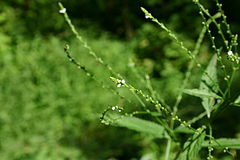Verbena urticifolia
| Verbena urticifolia subsp. var. | White Vervain | |||||||||||||||||||||||||||||||||||||||||||||||||||||||
|---|---|---|---|---|---|---|---|---|---|---|---|---|---|---|---|---|---|---|---|---|---|---|---|---|---|---|---|---|---|---|---|---|---|---|---|---|---|---|---|---|---|---|---|---|---|---|---|---|---|---|---|---|---|---|---|---|

|
|
| ||||||||||||||||||||||||||||||||||||||||||||||||||||||
| ||||||||||||||||||||||||||||||||||||||||||||||||||||||||
Verbena urticifolia (White Vervain) is a herbaceous plant in the vervain family (Verbenaceae). It belongs to the "true" vervains of genus Verbena.
White Vervain has opposite, simple leaves on thin, rigid, green stemswp. The small flowers are borne in spikes; they open in summer and unusually for this normally bluish-flowered genus are whitewp.
The flowers are hermaphrodite (have both male and female organs) and are pollinated by Bees, flies, Lepidoptera (Moths & Butterflies). The plant is self-fertile.
Cultivation
Succeeds in any moderately fertile well-drained but moisture retentive soil in a sunny position1 RH. Hardy to about -15°cRH.
Propagation
Seed - sow early spring in a greenhouse or cold frame1. When they are large enough to handle, prick the seedlings out into individual pots and plant them out in the summer. Division in spring. Larger divisions can be planted out direct into their permanent positions. We have found that it is best to pot up smaller divisions and grow them on in light shade in a greenhouse or cold frame until they are growing away well. Plant them out in the summer or the following spring. Basal cuttings in early summer. Harvest the shoots with plenty of underground stem when they are about 8 - 10cm above the ground. Pot them up into individual pots and keep them in light shade in a cold frame or greenhouse until they are rooting well. Plant them out in the summerpf.
Pests and diseases
Species
Gallery
If you have a photo of this plant, please upload it! Plus, there may be other photos available for you to add.
References
- Standard Cyclopedia of Horticulture, by L. H. Bailey, MacMillan Co., 1963
- http://www.pfaf.org/database/plants.php?Verbena+urticifolia
External links
- w:Verbena urticifolia. Some of the material on this page may be from Wikipedia, under the Creative Commons license.
- Verbena urticifolia QR Code (Size 50, 100, 200, 500)

